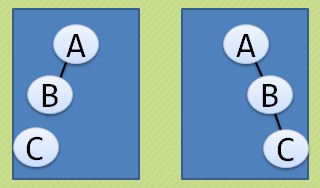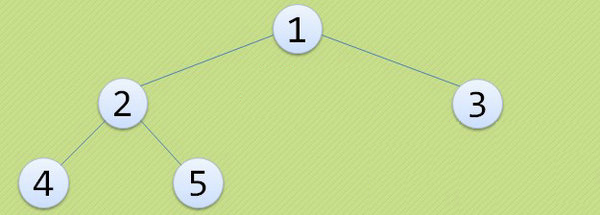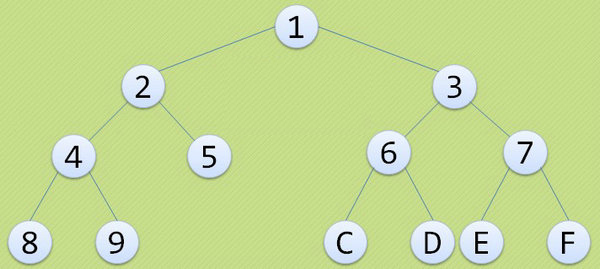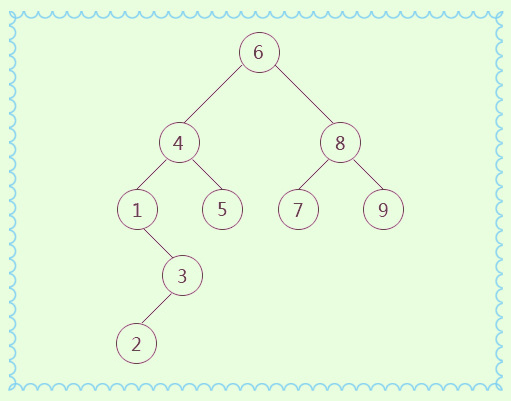1. 关于树
① 树的度 — 也即是宽度,简单地说,就是结点的分支数。
② 树的深度 — 组成该树各结点的最大层次。
③ 森林 — 指若干棵互不相交的树的集合。
④ 有序树 — 指树中同层结点从左到右有次序排列,它们之间的次序不能互换,这样的树称为有序树,否则称为无序树。
2. 二叉树的特点
i、每个结点最多有两颗子树
ii、左子树和右子树是有顺序的,次序不能任意颠倒
iii、即使树中某结点只有一颗子树,也要区分它是左子树还是右子树
3. 二叉树五种形态
① 空二叉树
② 只有一个根结点
③ 根结点只有左子树
④ 根结点只有右子树
⑤ 根结点既有左子树又有右子树

4. 特殊的二叉树
① 斜树:所有的结点都只有左子树的二叉树叫左斜树,所有的结点都只有右子树的二叉树叫右斜树,这两者统称为斜树。
② 满二叉树:在一棵二叉树中,如果所有分支结点都存在左子树和右子树,并且所有叶子都在同一层上,这样的二叉树称为满二叉树。
③ 完全二叉树:对一棵具有n个结点的二叉树按层序编号,如果编号为i (1<=i<=n) 的结点与同样深度的满二叉树中编号为i的结点位置完全相同,则这棵二叉树称为完全二叉树。
下图中不是完全二叉树,因为5没有左右子树,导致8,9,C,D,E,F 中间没有连续:
5. 二叉树的转换
将树转换为二叉树的步骤如下:
① 加线:所有兄弟节点之间加线
② 去线:保留树中每个结点与它第一个孩子的连线,删除其与其他孩子的连线
③ 层次调整:以根结点为轴心,将整棵树旋转,使之层次分明。
6. 二叉树的遍历(Java实现)
① 前序遍历:先访问根节点,再访问左子树,最后访问右子树。
② 中序遍历:先访问左子树,再访问根节点,最后访问右子树。
③ 后序遍历:先访问左子树,再访问右子树,最后访问根节点。
④ 层序遍历:从树的根结点开始,从上向下逐层访问,在同一层中,先左后右逐个访问。
public class LinkedBinaryTree {
private Node root; // 根节点
/**
* 内部节点类
*/
private class Node {
private Node leftChild; // 左子节点
private Node rightChild; // 右子节点
private int data;
public Node(int data) {
this.leftChild = null;
this.rightChild = null;
this.data = data;
}
}
public LinkedBinaryTree() {
root = null;
}
/**
* 递归创建二叉树
*
* @param node
* @param data
*/
public void buildTree(Node node, int data) {
if (root == null) {
root = new Node(data);
} else {
if (data < node.data) {
if (node.leftChild == null) {
node.leftChild = new Node(data);
} else {
buildTree(node.leftChild, data); // 递归遍历左子树
}
} else {
if (node.rightChild == null) {
node.rightChild = new Node(data);
} else {
buildTree(node.rightChild, data); // 递归遍历右子树
}
}
}
}
/**
* 前序遍历(递归实现)
*
* @param node
*/
public void preOrderTraverse(Node node) {
if (node != null) {
System.out.print(" " + node.data + " ");
preOrderTraverse(node.leftChild);
preOrderTraverse(node.rightChild);
}
}
/**
* 中序遍历(递归实现)
*
* @param node
*/
public void inOrderTraverse(Node node) {
if (node != null) {
inOrderTraverse(node.leftChild);
System.out.print(" " + node.data + " ");
inOrderTraverse(node.rightChild);
}
}
/**
* 后序遍历(递归实现)
*
* @param node
*/
public void postOrderTraverse(Node node) {
if (node != null) {
postOrderTraverse(node.leftChild);
postOrderTraverse(node.rightChild);
System.out.print(" " + node.data + " ");
}
}
/**
* 前序遍历(非递归实现)
*
* @param node
*/
public void preOrderTraverseNoRecursion(Node node) {
Stack<Node> stack = new Stack<Node>();
if (node != null) {
stack.push(node); // 元素进栈
while (!stack.isEmpty()) {
node = stack.pop(); // 栈顶元素出栈
System.out.print(" " + node.data + " ");
if (node.rightChild != null)
stack.push(node.rightChild);
if (node.leftChild != null)
stack.push(node.leftChild);
}
}
}
/**
* 中序遍历(非递归实现)
*
* @param node
*/
public void inOrderTraverseNoRecursion(Node node) {
Stack<Node> stack = new Stack<Node>();
while ((node != null) || (!stack.isEmpty())) {
if (node != null) {
stack.push(node);
node = node.leftChild;
} else {
node = stack.pop();
System.out.print(" " + node.data + " ");
node = node.rightChild;
}
}
}
/**
* 后序遍历(非递归实现)
*
* @param node
*/
public void postOrderTraverseNoRecursion(Node node) {
Stack<Node> stack = new Stack<Node>();
Node preNode = null;
if (node != null) {
stack.push(node);
while (!stack.isEmpty()) {
node = stack.peek();
if ((node.leftChild == null && node.rightChild == null)
|| (preNode != null && (preNode == node.leftChild || preNode == node.rightChild))) {
System.out.print(" " + node.data + " ");
stack.pop();
preNode = node;
} else {
if (node.rightChild != null)
stack.push(node.rightChild);
if (node.leftChild != null)
stack.push(node.leftChild);
}
}
}
}
/**
* 层序遍历(非递归实现)
*
* @param node
*/
public void levelOrderTraverse(Node node) {
Queue<Node> queue = new LinkedList<Node>();
if (node != null) {
queue.offer(node); // 将元素插入队列
while (!queue.isEmpty()) {
node = queue.poll(); // 队列头部出列
System.out.print(" " + node.data + " ");
if (node.leftChild != null)
queue.offer(node.leftChild);
if (node.rightChild != null)
queue.offer(node.rightChild);
}
}
}
/**
* 测试方法
*
* @param args
*/
public static void main(String[] args) {
int[] arr = { 6, 4, 8, 1, 7, 3, 9, 2, 5 };
LinkedBinaryTree bTree = new LinkedBinaryTree();
// 构建一棵二叉树
for (int i = 0; i < arr.length; i++) {
bTree.buildTree(bTree.root, arr[i]);
}
bTree.preOrderTraverse(bTree.root); // 前序遍历(递归)
bTree.inOrderTraverse(bTree.root); // 中序遍历(递归)
bTree.postOrderTraverse(bTree.root); // 后序遍历(递归)
bTree.preOrderTraverseNoRecursion(bTree.root); // 前序遍历(非递归)
bTree.inOrderTraverseNoRecursion(bTree.root); // 中序遍历(非递归)
bTree.postOrderTraverseNoRecursion(bTree.root); // 后序遍历(非递归)
bTree.levelOrderTraverse(bTree.root); // 层序遍历(非递归)
}
}打印结果:
① 前序遍历(递归) :6 4 1 3 2 5 8 7 9
② 中序遍历(递归) :1 2 3 4 5 6 7 8 9
③ 后序遍历(递归) :2 3 1 5 4 7 9 8 6
④ 前序遍历(非递归):6 4 1 3 2 5 8 7 9
⑤ 中序遍历(非递归):1 2 3 4 5 6 7 8 9
⑥ 后序遍历(非递归):2 3 1 5 4 7 9 8 6
⑦ 层序遍历(非递归):6 4 8 1 5 7 9 3 2





























 4796
4796











 被折叠的 条评论
为什么被折叠?
被折叠的 条评论
为什么被折叠?








